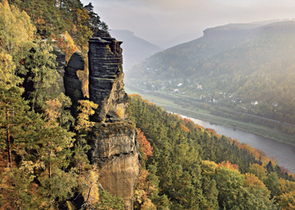Nature Conservation 3/2012 — 17. 10. 2012 — On Nature in the Czech Republic — Print article in pdf
Bauer P., Stein K., Kopecký V. et al.: The Landscape Born from Sea – 40 Years since Establishing the
40 let od vyhlášení CHKO Labské pískovce

The sandstone landscape in northern Bohemia, also known as the České Švýcarsko/Bohemian Switzerland, was declared a Protected Landscape Area (PLA) in 1972.
At that time, the PLA covered 324 km2, followed up by a PLA just in neighbouring Saxony. In 2000, a part of the Czech PLA became the České Švýcarsko/Bohemian Switzerland National Park. Mesozoic sandstones, which had been later influenced by volcanic activities, are bedrock within the area. The current landscape scenery was finally shaped by erosion in the Quaternary Period. In addition to bedrock and relief, flora is influenced by the fading Oceanic climate as well as by human activities. The Elbe River runs through the landscape. On its floodplain deposits, there is the last site in the Czech Republic where the Strapwort (Corrigiola litoralis) occurs. Due to the Atlantic Salmon (Salmo salar) re-introduction into the Elbe River having been carried out since 1998, the PLA was repopulated through the important migration route by the above fish species. Some Black Stork (Ciconia nigra) pairs regularly breed in the PLA and since the mid-1990s the Peregrine (Falco peregrinus) has been also nesting there. The oldest evidence for human presence there is from the Mesolithic period. The landscape scenery had been step-by-step modified by continuing human colonization: the ratio between forested area and those settled by humans had been particularly changed. Later, the human settlements were influenced by the industrial development and expulsion of Germans after the World War II. The later event resulted in destruction of valuable folk architecture buildings and decline in agriculture. In addition to performing state/public administration, the Labské pískovce/Elbe Sandstone PLA Administration provides measures to maintain and restore valuable natural or semi-natural habitats.

